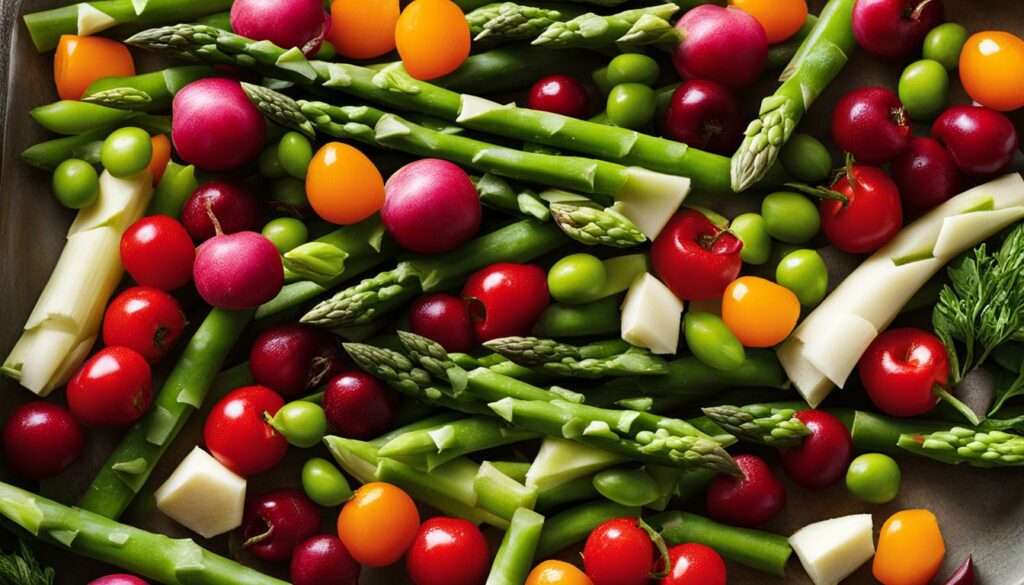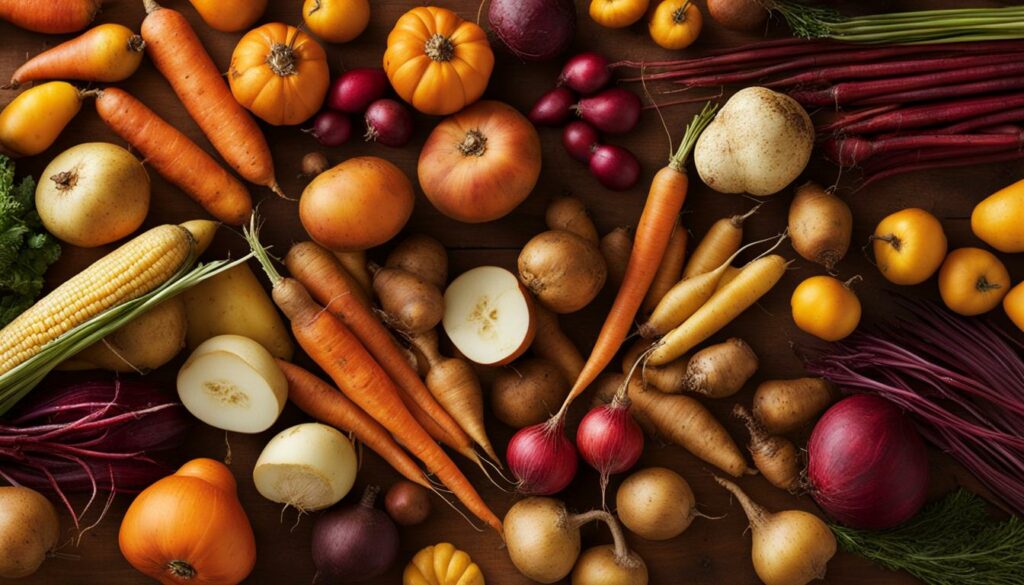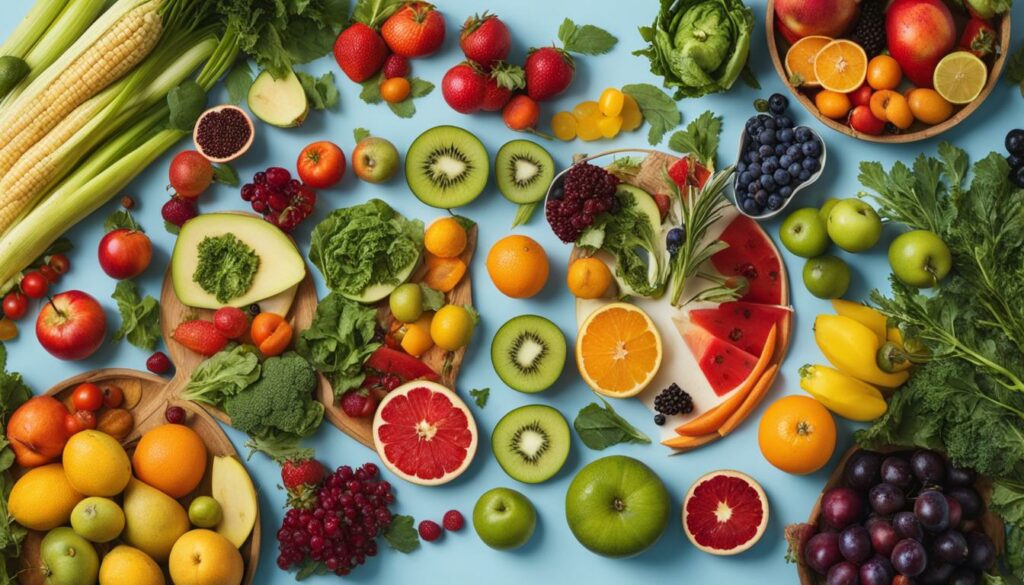Seasonal eating is a practice that involves consuming food items that are in season during a specific time of year. It focuses on embracing the natural cycle of produce availability to enjoy fresh flavors and maximize the nutritional benefits of different fruits and vegetables. By following a seasonal eating guide, individuals can explore a wide variety of fresh choices year-round, support local farms, and adopt a sustainable approach to their diet.
Key Takeaways:
- Eating seasonally allows you to enjoy fresh and flavorsome produce.
- It encourages supporting local farms and adopting a sustainable eating habit.
- By eating in season, you can maximize the nutritional benefits of fresh fruits and vegetables.
- Seasonal eating offers a wide variety of ingredients for creative and delicious seasonal recipes.
- Planning meals around seasonal produce enables a balanced and healthy diet.
The Importance of Incorporating Seasonal Foods Into Your Diet
Incorporating seasonal foods into your diet is not only a culinary delight but also offers numerous benefits for your health and the environment. Seasonal foods are known to taste better because they are harvested at the peak of ripeness and are fresher compared to out-of-season produce. This results in enhanced flavors, textures, and aromas that can elevate your meals.
The Peak of Freshness: Why Seasonal Foods Taste Better
When you choose seasonal foods, you’re selecting ingredients that have been allowed to fully develop and mature under optimal conditions. Unlike out-of-season produce that is often picked prematurely and then transported long distances, seasonal foods are picked at the peak of their freshness. This means that they retain more nutrients, have a higher water content, and are naturally sweeter and juicier. The result is a superior taste experience that can truly awaken your palate.
Additionally, seasonal foods are typically grown closer to your location, reducing the time and distance between harvest and consumption. Thus, they spend less time traveling and in storage, preserving their freshness and maximizing their nutritional value. Eating foods that are in season allows you to enjoy them at their very best.
Health Benefits of Eating Seasonally
Seasonal eating not only enhances the taste of your meals but also provides numerous health benefits. Seasonal foods are packed with essential nutrients and antioxidants that support your overall well-being. Fruits and vegetables, in particular, are rich in vitamins, minerals, and fiber, which are crucial for maintaining a healthy immune system, promoting digestion, and reducing the risk of chronic diseases.
By consuming a wide variety of seasonal produce, you can ensure that your diet is well-balanced and nutrient-dense. Each season brings its own unique offerings, allowing you to explore a range of flavors and nutritional profiles. Whether it’s the vibrant berries of summer, the hearty root vegetables of autumn, or the citrus-packed goodness of winter, embracing seasonal eating allows you to reap the nutritional benefits of nature’s bounty.
Sustainability and Supporting Local Farms Through Seasonal Choices
Choosing seasonal foods also aligns with sustainable and eco-friendly practices. By opting for local, in-season produce, you reduce the carbon footprint associated with long-distance transportation and the need for artificial preservation methods. Local farms play an essential role in supplying seasonal foods, and supporting them contributes to the preservation of agricultural biodiversity and the local economy.
Eating locally sourced food not only supports local farmers but also fosters a sense of community. It allows you to connect with the people and places responsible for cultivating the food on your plate. You can visit farmers’ markets, join community-supported agriculture programs, or even directly purchase from local farms to get the freshest seasonal produce available.
In summary, incorporating seasonal foods into your diet is a rewarding choice that offers enhanced taste, improved nutrition, and a positive impact on the environment. By embracing the cycles of nature and supporting local farms, you not only enjoy the freshest and most flavorful ingredients but also contribute to a sustainable food system that benefits both you and the planet.
Spring Into Flavor: Selecting the Best Seasonal Produce
Spring brings a vibrant array of seasonal produce that adds freshness and flavor to any meal. During this season, some of the best fruits and vegetables include asparagus, strawberries, rhubarb, artichokes, peas, and spinach. These ingredients can be used to create delicious salads, stir-fries, smoothies, and other dishes that celebrate the flavors of spring.
Take advantage of the abundance of spring seasonal produce to create colorful and nutritious meals that embrace the essence of this season’s vibrant flavors. Asparagus, with its tender stalks and earthy taste, can be roasted or grilled to perfection and paired with a light lemon drizzle. Strawberries, bursting with sweetness, can be featured in refreshing fruit salads or turned into delectable desserts. Rhubarb, known for its tartness, can be stewed and used as a versatile filling for pies and tarts. Artichokes, with their mild and slightly nutty flavor, can be steamed and enjoyed with a savory dipping sauce. Peas, whether in their pods or shelled, bring a delicate sweetness and vibrant green color to spring dishes like risottos or pasta salads. Spinach, a nutrient-rich leafy green, can be added to salads or cooked into savory dishes like quiches or lasagnas.
When selecting spring fruits and vegetables, look for those that are firm, brightly colored, and fragrant. Avoid any signs of wilting, browning, or mold, as these indicate that the produce is past its prime. Opt for locally sourced options whenever possible, as they tend to be fresher and support local farmers.
To make the most of your spring produce, try incorporating seasonal recipes for spring into your meal planning. Explore new flavors, experiment with different cooking techniques, and let the fresh ingredients inspire you to create innovative and delicious dishes. Whether you’re enjoying a light and refreshing spring salad, a flavorful stir-fry, or a vibrant smoothie bowl, let the bounty of spring produce take center stage in your spring meal ideas.
With their vibrant colors and fresh flavors, spring fruits and vegetables are sure to infuse your meals with the essence of the season. So, embrace the bounty of spring and savor the delicious tastes that this season has to offer!

Summer’s Bounty: Embracing the Harvest for Peak Nutrition
Summer is a season of abundance when it comes to fresh produce. It’s the perfect time to indulge in the vibrant flavors and nutritional benefits of summer fruits and vegetables. The bounty of summer offers an array of delicious ingredients that can elevate your meals and support your overall well-being.
Stone Fruits and Berries: Summer’s Nutritional Powerhouses
One of the highlights of summer produce is the availability of stone fruits such as peaches, plums, and cherries. These fruits not only tantalize your taste buds but also pack a punch when it comes to nutritional benefits. Stone fruits are rich in vitamins A and C, as well as dietary fiber, which helps support digestion and promotes a healthy gut. Moreover, they contain antioxidants that help combat inflammation and protect against chronic diseases.
In addition to stone fruits, summer is the time to relish in the abundance of berries like blueberries, raspberries, and blackberries. These antioxidant powerhouses are bursting with flavor and offer a range of health benefits. Berries are packed with vitamins, minerals, and phytochemicals, all of which contribute to their status as superfoods. They are known for their potential to improve brain health, boost immune function, and support heart health.
Summer Vegetables: From Sweet Corn to Succulent Tomatoes
Summer also brings an assortment of vibrant and nutrient-packed vegetables to the table. Sweet corn, juicy tomatoes, crisp zucchini, and refreshing cucumbers are just a few examples of the seasonal treasures you can enjoy. These vegetables are not only delicious but also provide essential vitamins, minerals, and fiber that contribute to overall health and well-being.
Sweet corn, a quintessential summer vegetable, is a good source of dietary fiber and contains important antioxidants like lutein and zeaxanthin, which promote eye health. Tomatoes, another summer favorite, are rich in lycopene, a powerful antioxidant that has been linked to a reduced risk of certain cancers and heart disease. Zucchini and cucumbers are hydrating vegetables that are low in calories and high in water content, making them perfect for staying hydrated during the warm summer months.
Incorporating these seasonal summer ingredients into your meals not only adds flavor and variety but also helps you stay nourished and hydrated during the hot season. Experiment with refreshing salads, savory grilled dishes, and light stir-fries to make the most of the summer bounty.
Whether you’re enjoying the juicy sweetness of stone fruits and berries or savoring the crispness of summer vegetables, the bounty of summer produce offers a plethora of nutritional benefits. Embrace the vibrant colors, flavors, and textures that summer brings, and create delicious meals that celebrate the peak nutrition of the season.
Autumn’s Harvest: Root Vegetables and Orchard Fruits
Autumn is a season of abundant harvests, with a wide variety of root vegetables and orchard fruits coming into their prime. These seasonal ingredients not only bring rich flavors and textures to your meals but also offer a range of nutritional benefits.
Root vegetables are hearty and versatile, making them perfect for fall recipes. Beets, carrots, and sweet potatoes are popular choices that can be roasted, mashed, or added to soups and stews to create comforting and nourishing dishes. These root vegetables are packed with essential vitamins, minerals, and fiber, supporting a healthy immune system and digestion.

In addition to root vegetables, autumn also marks the peak season for orchard fruits like apples and pears. These fruits are not only delicious on their own but can also be used in a variety of recipes. From classic apple pies to pear crumbles and tart apple cider, there are countless ways to incorporate these autumn gems into your desserts and baked goods.
Autumn recipes featuring root vegetables and orchard fruits can be both comforting and nutritious, providing a balance of flavors and textures. Whether you’re looking for satisfying meal ideas or indulgent treats, the seasonal produce of autumn offers endless possibilities.
To make the most of autumn’s harvest, consider trying out fall meal ideas like roasted root vegetable medleys, apple and beet salad, or pear and gingerbread crumble. These dishes showcase the flavors of the season while incorporating the goodness of seasonal autumn ingredients.
So, embrace the bounty of autumn and explore the rich flavors and nutritional benefits of root vegetables and orchard fruits in your fall recipes. Whether you’re cooking for yourself or hosting a gathering, incorporating autumn’s seasonal produce will ensure that your meals are both delicious and nourishing.
Winter Wellness: Cold-Weather Crops and Citrus Galore
While winter often brings a limited selection of fresh produce, there are still plenty of nutritious options available. Embracing the seasonal bounty of winter can help you maintain a healthy diet even during the chilly months. From vibrant citrus fruits to hearty winter roots and greens, there are plenty of delicious and wholesome ingredients to explore.
Citrus Fruits: Vitamin C Heroes During the Chillier Months
Citrus fruits like oranges, grapefruits, and lemons are in season during the colder months, making them a delightful addition to your winter meals. These fruits are not only flavorful but also rich sources of vitamin C, which is essential for supporting your immune system. Incorporating citrus fruits into your diet can help ensure you get your recommended daily dose of vitamin C while enjoying their refreshing taste.
Winter Roots and Greens: Staying Healthy with Hearty Produce
Winter offers a variety of roots and greens that thrive in the cold weather and provide essential nutrients to keep you healthy. Carrots, turnips, kale, and Brussels sprouts are just a few examples of the hearty and nutritious options available during this season. These vegetables not only add depth to your winter dishes but also provide a range of vitamins, minerals, and antioxidants to support your overall well-being.
By incorporating winter roots and greens into your meals, you can elevate the nutritional value of your dishes and indulge in the flavors of the season. Try roasting root vegetables or sautéing winter greens for a hearty and satisfying side dish. These ingredients also work well in soups, stews, and casseroles, adding warmth and nourishment when you need it most.
Seasonal Eating Guide: Planning Your Meals Around the Year
Planning your meals around the seasons allows you to enjoy a wide variety of fresh produce while maintaining a balanced and nutritious diet. By incorporating seasonal ingredients into your meal planning, you can create flavorful and wholesome dishes that align with your dietary preferences and health goals.
Whether you prefer meal planning, meal prep, or experimenting with new recipes, a seasonal eating guide can provide recipe inspiration and ensure that you make the most of the available produce throughout the year. By choosing seasonal ingredients, you can keep your dishes interesting and take advantage of the unique flavors each season has to offer.
“Meal planning is a great way to stay organized and on track with your healthy eating habits.”
A balanced diet includes a variety of fruits, vegetables, whole grains, lean proteins, and healthy fats. By incorporating seasonal foods, you can achieve this balance while also enjoying the benefits of fresh and flavorful ingredients. Whether you’re looking for seasonal meal ideas for breakfast, lunch, dinner, or snacks, the abundance of seasonal produce will keep your meals exciting and nutritious.
Meal prepping is another effective strategy for incorporating seasonal foods into your diet. Taking the time to plan and prepare your meals in advance can save you time and ensure that you have healthy options readily available throughout the week. By dedicating a few hours to meal prep, you can create balanced meals that are packed with seasonal ingredients, ready to grab and go whenever you need them.
| Benefits of Seasonal Eating | Benefits of Meal Planning |
|---|---|
| 1. Fresher and more flavorful ingredients | 1. Saves time throughout the week |
| 2. Supports local farms and promotes sustainability | 2. Reduces food waste |
| 3. Maximizes nutritional value | 3. Helps with portion control |
| 4. Adds variety to your meals | 4. Enables healthier dietary choices |
By incorporating seasonal meal ideas into your meal planning, you can broaden your palate, experiment with new flavors, and appreciate the natural diversity of each season. Whether you’re a seasoned chef or a novice in the kitchen, seasonal eating encourages creativity and allows you to explore different cooking techniques and recipes.
So, next time you’re planning your meals, keep a seasonal eating guide in mind. Take advantage of the bountiful produce each season brings and enjoy the benefits of a balanced and nutritious diet.
Conclusion
Embracing a seasonal eating guide offers a multitude of benefits for your healthy diet and the environment. By incorporating fresh produce that is in season, you can enjoy a variety of nutrient-rich ingredients, create delicious meals, and contribute to a more sustainable food system.
One of the primary advantages of seasonal eating is access to fresh and flavorful produce. When fruits and vegetables are in season, they are at their peak of ripeness, resulting in superior taste, texture, and aroma. By enjoying the abundance of seasonal foods, you can elevate your culinary experiences and satisfy your taste buds.
Furthermore, following a seasonal eating guide supports local farms and the community. By purchasing produce from local farmers, you can directly contribute to their livelihoods and the local economy. Additionally, embracing seasonal eating reduces the carbon footprint associated with long-distance transportation and promotes sustainable eating.
For those seeking to improve their overall health, seasonal eating provides a wealth of nutrition benefits. Seasonal produce is packed with essential nutrients and antioxidants, which can help boost your immune system, promote healthy digestion, and support overall well-being.
To start reaping the rewards of a vibrant and sustainable diet, begin incorporating seasonal foods into your meals. Whether it’s spring, summer, autumn, or winter, there are always fresh choices available. Follow a seasonal eating guide and discover the wonders of embracing nature’s bountiful offerings.
How Can Seasonal Eating Contribute to Sustainable Living?
Seasonal eating is one of the most effective sustainable living tips people can follow. By consuming fruits and vegetables that are in season, individuals lower the carbon footprint generated by food production and transportation. It also supports local farmers and reduces the use of pesticides and preservatives.
Source Links
- https://www.marthastewart.com/8383524/seasonal-produce-guide
- https://www.healthline.com/nutrition/seasonal-food
- https://naturespath.com/blogs/posts/whats-in-season-all-year-round-seasonal-produce-guide

